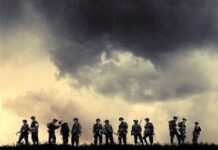It’s springtime, a time for Easter, Spring Break, the NBA and NHL playoffs, the NFL draft, and the beginning of the end of the school year. Unfortunately, spring also means a weak season for movies. As of April 28, four of the top five films at the box office had “rotten” ratings on the review aggregator website Rotten Tomatoes, meaning that less than 60% of critics enjoyed them. Furthermore, out of the top ten movies at the box office, only one film, Source Code, has a rating above 75%.
The next few weeks aren’t looking any better either. What do we have to look forward to between now and the end of the school year? Another Fast and Furious sequel, a sequel to the 2006 animated film Hoodwinked (which itself has a 48% on Rotten Tomatoes), and a Disney movie, simply titled Prom. Ouch.
So, what are you to do if you find yourself in the mood for a good film, then? Reacquaint yourself with the classics.
It’s a shame that most kids today aren’t familiar with the great movies of the 1930s, 40s, and 50s, or even with Oscar winners from recent decades. Well, that’s where I come in. I’ve come up with five great classic movies that I think everyone should see, and, to prevent you from wasting your time, I’ve left out the ones you’ve probably already seen – you know, The Godfather, Forrest Gump, Saving Private Ryan, Gladiator, etc. So pull up your Netflix queue or head to your local Blockbuster (they could really use your business) and check out these movies.
Duck Soup (1933) – When I first saw that the prestigious American Film Institute ranked this movie as the fifth funniest of all time, and that it occupied a spot on AFI’s Top 100 Movies of All Time List, I was quite surprised. After all, how funny could a movie from the early 30s be? Well, obviously, I hadn’t been introduced to the Marx brothers: Groucho, Harpo, Chico, and Zeppo.
The last movie to feature all four of them (Zeppo left after this movie), Duck Soup tells the story of a comical dictator (Groucho) who ticks off the leader of another country, resulting in a rivalry and eventually a war that climaxes in a hilarious final battle. Full of ridiculous, slapstick humor and puns (think Airplane!) Duck Soup will keep you entertained all the way through.
Mr. Smith Goes to Washington (1939) – Coming from what many critics consider to be one of the best years ever in cinema (The Wizard of Oz and Gone With the Wind were also from ’39), this powerful film shows the sheer determination of one man who stands up against a corrupt system. Directed by Frank Capra, Mr. Smith Goes to Washington tells the story of a small town man, Jefferson Smith (played by the great James Stewart) who is elected to the U.S. Senate.
Initially overwhelmed and awe-struck by the glamour and prestige of Washington, D.C., Smith decides to write a bill establishing a camp for his hometown Boy Scouts, only to find out how difficult a pursuit that is in such a corrupt political system. With the help of his assistant, he decides to take a stand. The film is named to AFI’s Top 100 Movies (#26) and Top 100 Inspirational Movies (#5).
Citizen Kane (1941) – An absolute must-see. Ranked by the AFI as the greatest movie of all time (which many critics, including the revered Roger Ebert, agree with), Citizen Kane was a revolutionary film that used many techniques unheard of for movies at the time, such as a non-linear time structure. The story opens with the death of Charles Foster Kane, a mogul whose last word before dying, “rosebud,” intrigues a group of reporters who set out to discover its meaning.
The story is told through flashbacks (think Forrest Gump), as several of the people who knew Kane best are interviewed and his entire back-story is revealed. Kane is taken from his home at an early age and raised under Mr. Thatcher, a successful business magnate and Kane’s early financial advisor. He decides to go into journalism, takes over the struggling New York Inquirer and turns it into a profitable business, his first step on his path to becoming a media tycoon.
As he grows up he gains more power, eventually starting more newspapers, building opera houses, and even running for governor; however, a dark transition takes place, as the idealistic young newspaperman turns into a greedy magnate who isolates himself from society in his gargantuan mansion, “Xanadu.” The movie culminates in an epic final scene in which it is finally revealed what “rosebud” means and the whole story comes together, awing the viewer in the process.
2001: A Space Odyssey (1968) – Okay, okay I’ll admit it – 2001: A Space Odyssey is not the most exciting movie ever. Unlike other classic sci-fi films, such as Star Wars or Terminator, 2001 doesn’t feature explosions, guns, battles, or light sabers. It doesn’t even feature big name actors. Yet, somehow, it’s the most influential sci-fi movie ever made. The reason it’s a must-see is because it’s so different from what we’re usually accustomed to in these types of movies. Rather than focusing on epic space battles, 2001 (directed by the one-and-only Stanley Kubric) explores topics like evolution, artificial intelligence and life on other planets. Because 2001 is a rather open-ended movie with no clear-cut plot, it proves difficult to explain.
The movie has a strange storyline divided into four parts: “The Dawn of Man” (apes discover a mysterious black monolith), “TMA-1” (astronauts discover the same monolith on the moon), “Jupiter Mission” (a ship on a mission to Jupiter is sabotaged by its on-board computer, HAL), and “Jupiter and Beyond the Infinite” (one of the astronauts from the Jupiter mission hurdles through a light-tunnel in space).
All four parts are tied together by one thing: a mysterious black monolith, a creature which invariably steals the attention in every one of its scenes. From its first appearance as it is discovered by apes in “The Dawn of Man” to its appearance in the final scene (I don’t want to spoil the movie), the black monolith provides a sense of mystery to the film.
In addition to its great cinematography and visual effects (for which it won an Oscar), 2001 also features a great score composed of classical pieces like the famous Blue Danube waltz. Gyorgy Ligeti’s Requiem is played every time the monolith appears, only increasing the creature’s creepiness. And of course you have the classic, recognizable Thus Spake Zarathustra tonal poem, which plays during the opening and closing of the film.
Even though some of 2001 can be boring (the light-tunnel sequence in Jupiter and Beyond the Infinite is a tad too long) it remains a classic and probably the greatest example of the genius of Stanley Kubrick. It was named to AFI’s Top 10 Sci-Fi Movies (#1) and Top 100 Movies (#15).
Unforgiven (1992) –This 1992 Oscar winner for Best Picture unites two of the best actors of our time, Clint Eastwood and Morgan Freeman, to paint a portrait of a retired gunslinger called back into action for one last job.
After a woman is brutally attacked in a small Wyoming town, the notorious William Munney (Eastwood), reformed since his gun-slinging days, reluctantly accepts the job to punish those who committed the crime and enlists the help of his partner, Ned Logan (Freeman). They reach the town to search for the wanted men, only to find that its sheriff (Gene Hackman, who won a Best Supporting Actor Oscar for the role) strictly prohibits bounty hunters and weapons in his town. As the movie continues Munney slowly reverts to his old ways, becoming the notorious killer he once was.
A stark contrast to the older cowboy films of the 30, 40s and 50s, Unforgiven is a darker Western that features characteristics not usually seen in these types of movies: rather than a valiant sheriff fighting off bandits on tumbleweed infested plains, Unforgiven has a flawed protagonist battling a sheriff so obsessed with preventing violence that he ends up using it. It was named to AFI’s Top 10 Westerns (#4) and Top 100 Movies (#68).
Sources: www.imdb.com, www.rottentomatoes.com, http://www.afi.com/100years/movies10.aspx, http://www.afi.com/10top10/, http://www.afi.com/100Years/cheers.aspx






